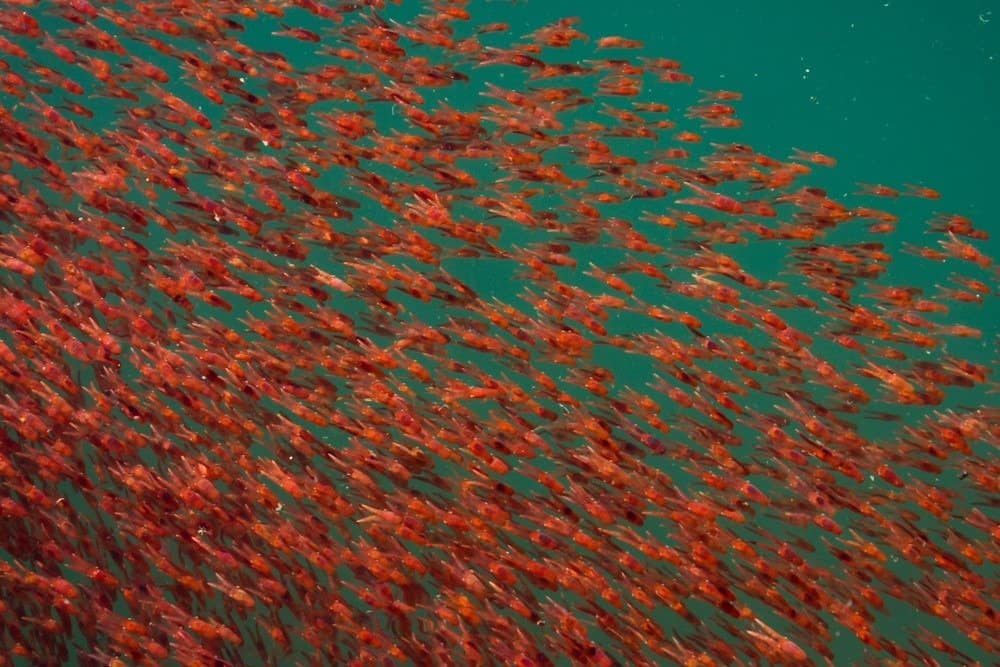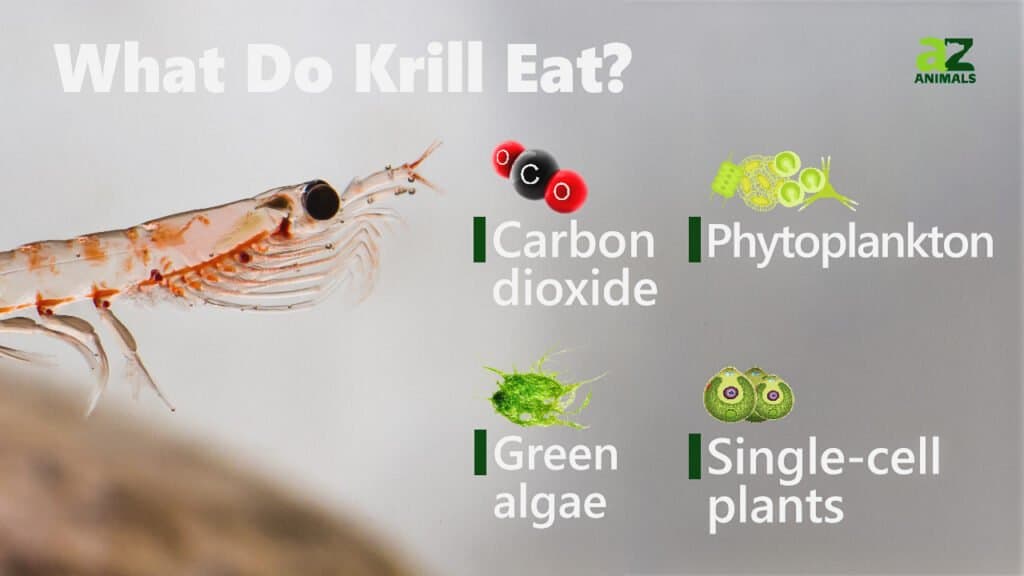The world’s oceans are filled with incredible wildlife. From massive blue whales to incredible predators like the great white shark, much of the planet’s biodiversity lies under the waves. Some of the species in the water are very important to the planet’s food chain. Despite their diminutive sizes, krill and shrimp are two keystone species that help support the rest of the world’s food supply. Although they look alike, it’s possible to tell krill vs shrimp apart by closely examining them.
Learn how to tell these creatures apart and see why they’re so significant to all other life on the planet, including humans!
Comparing a Krill and a Shrimp

| Krill | Shrimp | |
| Size | Weight: 0.07 ounces Length: 0.8in -2.4 in | Weight: 0.64 ounces- 10 ounces Length: 0.8in-9.8in |
| Morphology | – Three segments called the cephalothorax, pleon, and tail fan -Two antennae – Complex compound eyes – 6-8 pairs of legs on their thorax used – 5 swimmerets on their abdomen | – Two segments called the cephalothorax and the abdomen -Two pairs of antennae – Compound eyes – 10 legs, 5 for walking and 5 for swimming |
| Body Color | Transparent in most cases – Will also have pink and red pigment spots in their exoskeleton | – Bright and colorful – Red, pink, light brown |
| Water Type | – Saltwater only – Live in all the world’s oceans, especially the Southern Ocean – Can live in very cold water | – Saltwater and freshwater depending on species |
| Number of Species | 85 species | 1,900 species |
| Diet | Algae, phytoplankton, single-celled plants | Algae, small fish, plankton, aquatic plants |
The Key Differences Between Krill vs Shrimp

Shrimp are larger than krill, have more color varieties, and have two sections in their bodies
©SritanaN/Shutterstock.com
The greatest differences between krill and shrimp include their size, morphology, and body color. Krill are smaller than shrimp. The former has a body with three segments rather than the two that shrimp have, and have a mostly transparent exoskeleton with pink hues instead of the shrimp’s distinct pinkish brown color.
These differences between krill and shrimp might not seem too significant at first glance. After all, they’re both small, water-dwelling arthropods that have a lot of legs and antennae. We’re going to examine both animals in greater depth to help you learn how they’re different.
Krill vs Shrimp: Size
Krill are smaller than shrimp. The average krill weighs about 0.07 ounces and grows between 0.8 inches and 2.4 inches. Despite their name being a term for small things, some shrimp can reach about 10 ounces in weight and 9.8 inches in length.
For the most part, krill are very small and live in large groups called swarms. Those swarms are massive enough to support many ocean creatures, including blue whales. Although they’re small, krill represent a large portion of baleen whales’ diet, and they comprise a large part of many other marine animals’ diets.
Both shrimp and krill are keystone species in many bodies of water, meaning they are necessary to the propagation of life in several areas but not all of them. Antarctic krill is certainly a keystone species in the Southern Ocean.
Krill vs Shrimp: Morphology
Krill are unique from shrimp because they have three segments in their bodies while shrimp only have two segments in their bodies. The three segments of a krill are called cephalothorax, pleon, and tail fan. Shrimp only have the cephalothorax and abdomen, also called the pleon.
Krill have two antennae, complex compound eyes, and between 6 and 8 pairs of legs on their thorax. They also have 5 swimmerets, or swimming legs, on their abdomens. Shrimp have two pairs of antennae, compound eyes, and 10 legs like all other decapods. Shrimp use 5 of their legs for walking and 5 of them for swimming.
Krill and shrimp have very different bodies, but it can take a trained eye to pick them apart just by their morphology.
Krill vs Shrimp: Body Color

Krill have transparent exoskeletons but red and pink pigmentation in some species
©Apple Pho/Shutterstock.com
Shrimp are bright and colorful, often integrating red, pink, and light brown into their bodies. However, some creatures that people consider shrimp but are not, like mantis shrimp, will have a whole variety of colors in them including blue, green, and yellow.
Krill have transparent exoskeletons, but they can also have red and pink hues to them. When krill gather in a swarm near the surface of the water, it will look pink!
Krill vs Shrimp: Water Type
Krill live only in saltwater, but shrimp can live in saltwater and freshwater. Although there is some debate as to whether freshwater shrimp are actually shrimp or considered prawns, the Atyidae family of shrimp are true shrimp and live in freshwater.
Krill live in all the oceans of the world, but a great deal of them live in the Southern Ocean and waters around Antarctica. They can survive in very cold waters, and that allows them to live in places where they are consumed by whales, penguins, and other creatures that dwell in these areas.
Krill vs Shrimp: Number of Species
Only 85 species of krill exist in the world, but they still have a massive total biomass of 379 million tons or more. Roughly 1,900 species of shrimp exist in the world today, and their estimated biomass exceeds 1.7 billion tons, even more than krill.
Both of these creatures make up a large and significant portion of the food chain. Part of their importance stems from the sorts of foods they eat to turn into energy.
Krill vs Shrimp: Diet

Krill eat algae, phytoplankton, and single-celled plants for the most part. However, shrimp eat algae, some small fish, plankton, and aquatic plants. The fact that these creatures can both take such small meals and turn them into energy that fuels their growth is significant.
By feeding on such small bits, these animals get large enough to support some of the biggest animals in the entire animal kingdom, like whales, sharks, and dolphins.
Krill and shrimp have many small differences, but they both share importance in the food chain. Although it can be hard to tell them apart by looking at a single characteristic, when you add all their differences together, differentiating these animals becomes very simple.
The photo featured at the top of this post is © RLS Photo/Shutterstock.com
Thank you for reading! Have some feedback for us? Contact the AZ Animals editorial team.






